
Avondale Agricultural Research Station
Encyclopedia
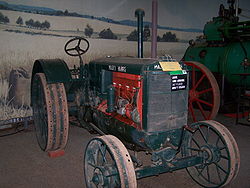
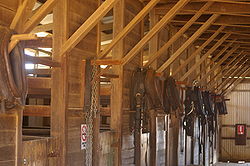
Farm
A farm is an area of land, or, for aquaculture, lake, river or sea, including various structures, devoted primarily to the practice of producing and managing food , fibres and, increasingly, fuel. It is the basic production facility in food production. Farms may be owned and operated by a single...
s and stations
Station (Australian agriculture)
Station is the term for a large Australian landholding used for livestock production. It corresponds to the North American term ranch or South American estancia...
operated by Western Australia's Department of Agriculture and Food. In addition to its research, Avondale has historical buildings, a farming equipment museum and operates as an agriculture education centre specialising in introducing primary school children to farming, and teaching of its history in Western Australia
Western Australia
Western Australia is a state of Australia, occupying the entire western third of the Australian continent. It is bounded by the Indian Ocean to the north and west, the Great Australian Bight and Indian Ocean to the south, the Northern Territory to the north-east and South Australia to the south-east...
.
Avondale is situated on land where the Dale River
Dale River (Western Australia)
Dale River was named after Robert Dale, the first European exlorer to venture into the Darling Ranges in Western Australia in 1829.The Dale river is a tributary of the Avon river, it joins the Avon 10 km west of Beverley near the Avondale Agricultural Research Station.Tributaries of the Dale...
joins the Avon River
Avon River (Western Australia)
The Avon River is a river in Western Australia. It is a tributary of the Swan River totalling 280 kilometres in length, with a catchment area of 125,000 square kilometres.-Catchment area:...
10 kilometres (6.2 mi) northwest of Beverley
Beverley, Western Australia
Beverley is a town located in the Wheatbelt region of Western Australia, south-east of the state capital, Perth, between York and Brookton on the Great Southern Highway...
. It is located on land originally granted to the first Governor of Western Australia
Governor of Western Australia
The Governor of Western Australia is the representative in Western Australia of Australia's Monarch, Queen Elizabeth II. The Governor performs important constitutional, ceremonial and community functions, including:* presiding over the Executive Council;...
, Captain (later Admiral Sir) James Stirling
James Stirling (Australian governor)
Admiral Sir James Stirling RN was a British naval officer and colonial administrator. His enthusiasm and persistence persuaded the British Government to establish the Swan River Colony and he became the first Governor and Commander-in-Chief of Western Australia...
and Captain Mark Currie
Mark John Currie
Captain Mark John Currie RN played a significant role in the exploration of Australia and the foundation of the Swan River Colony, later named 'Western Australia'....
RN
Royal Navy
The Royal Navy is the naval warfare service branch of the British Armed Forces. Founded in the 16th century, it is the oldest service branch and is known as the Senior Service...
in 1836. These grants were combined in 1849 and with additional land purchases they became known as Avondale Estate, expanding to in excess of 13330 acres (53.9 km²).
On 4 April 1924 the remaining 1740 acres (7 km²) of Avondale were passed on to the Department of Agriculture and Food. Initially Avondale continued its involvement with the Group Settlement Scheme
Group Settlement Scheme
The Group Settlement Scheme was an assisted migration scheme which operated in Western Australia from the early 1920s. It was engineered by Premier James Mitchell and followed on from the Soldier Settlement Scheme immediately after World War I...
, it was not until 1926 that research activities commenced. During the 1930s it was to be the laboratory for Dr Harold Bennetts
Harold William Bennetts
Harold William Bennetts CBE was a Veterinary surgeon known for his ground-breaking research into diseases and pathogens of livestock, especially the toxic effects of some native Australian plants.Born in Carlton, Victoria...
successful research into Bacillus ovitoxicus
Bacillus
Bacillus is a genus of Gram-positive, rod-shaped bacteria and a member of the division Firmicutes. Bacillus species can be obligate aerobes or facultative anaerobes, and test positive for the enzyme catalase. Ubiquitous in nature, Bacillus includes both free-living and pathogenic species...
. As part of Western Australia's 1979 sesquicentennial celebrations
WAY 1979
WAY '79, also referred to as WAY 79 and WAY 1979, was the official 1979 sesquicentennial celebration of the colonisation of Western Australia by Europeans.-Planning:...
a machinery museum was built and the other buildings were restored to original condition.
Early farm years
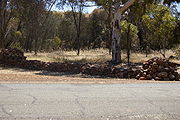
John Septimus Roe
John Septimus Roe was the first Surveyor-General of Western Australia. He was a renowned explorer, and a Member of Western Australia's Legislative and Executive Councils for nearly 40 years.-Early life:...
in King George Sound
King George Sound
King George Sound is the name of a sound on the south coast of Western Australia. Located at , it is the site of the city of Albany.The sound covers an area of and varies in depth from to ....
. Roe had made arrangement for both parties to return to the Swan River Colony
Swan River Colony
The Swan River Colony was a British settlement established in 1829 on the Swan River, in Western Australia. The name was a pars pro toto for Western Australia. In 1832, the colony was officially renamed Western Australia, when the colony's founding Lieutenant-Governor, Captain James Stirling,...
via an alternative route. The route was intended to join the settlements of King George Sound, York
York, Western Australia
York is the oldest inland town in Western Australia, situated 97 km east of Perth in the Avon Valley near Northam, and is the seat of the Shire of York...
and the Swan River Colony along with the newly established settlement of Williams
Williams, Western Australia
Williams is a town located in the Wheatbelt region of Western Australia, south-southeast of the state capital, Perth along Albany Highway and 32 kilometres west of Narrogin. The Williams River passes through the town. At the 2006 census, Williams had a population of 338.-History:Williams is...
. This expedition passed through the area of Avondale sighting the Dale River
Dale River (Western Australia)
Dale River was named after Robert Dale, the first European exlorer to venture into the Darling Ranges in Western Australia in 1829.The Dale river is a tributary of the Avon river, it joins the Avon 10 km west of Beverley near the Avondale Agricultural Research Station.Tributaries of the Dale...
and a granite hill that Roe name Bald Hill on 27 December. Bald Hill was to become the primary reference point for surveying the region.
In 1836, the surveyor Thomas Watson
Thomas Watson (surveyor)
Thomas Watson was a surveyor and early settler of the Swan River Colony in what is now Western Australia.Little is known of his early life, but he was trained as a surveyor before arriving at the Swan River Colony as part of Thomas Peel's settlement scheme, on board the Gilmore in 1830...
returned to area and used Bald Hill as the principal trigonometric reference. Watson was to map out a number of lots in the area including the western boundary for Beverley town site. Two of the lots surveyed were Avon location 14 with 5000 acres (20.2 km²), and Avon location K with 4000 acres (16.2 km²); location 14 was given to Captain Mark Currie, Fremantle Harbour Master, while location K was given to Stirling. Stirling as Governor and Currie as harbour master were not paid salaries by the colony but given land grants as compensation for their services. In 1978, surveyors using current equipment were engaged to determine the exact location of these original holdings, and commented on the remarkable accuracy of Watson's survey 142 years before.
Currie sold his grant of land to a Nicholas Carey in September 1838 for ₤330. Carey entered into a lease agreement in December with Governor Stirling for his grant, which included Carey purchasing the property at the end of the lease for ₤750 in 1846. Carey also purchased 3000 acres (12.1 km²) to west of location 14 he also received an additional grant of land in 1849. With all the land in the vee formed by the Avon River
Avon River (Western Australia)
The Avon River is a river in Western Australia. It is a tributary of the Swan River totalling 280 kilometres in length, with a catchment area of 125,000 square kilometres.-Catchment area:...
and the Dale River the property was now 13330 acres (53.9 km²) in size and was named Avondale Estate. During the late 1840s Carey moved to Guernsey
Guernsey
Guernsey, officially the Bailiwick of Guernsey is a British Crown dependency in the English Channel off the coast of Normandy.The Bailiwick, as a governing entity, embraces not only all 10 parishes on the Island of Guernsey, but also the islands of Herm, Jethou, Burhou, and Lihou and their islet...
leaving Avondale to be operated by an unknown caretaker.
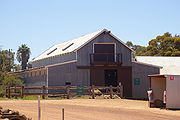
Nephew
Nephew is a son of one's sibling or sibling-in-law, and niece is a daughter of one's sibling or a sibling-in-law. Sons and daughters of siblings-in-law are also informally referred to as nephews and nieces respectively, even though there is no blood relation...
William Herbert deLisle. deLisle arrived and took up residence there in 1893, and assumed the land title in 1894. Avondale had been a pastoral property until deLisle's arrival, over the next ten years sections of the estate were sold off to fund its development. During this period, the house was expanded and the stable built, which included 20 horse stalls with hollow walls and an overhead loft. The hollow walls enable feed from the loft to gravitate directly to the feed bins in each stall.
The remaining 5232 acres (21.2 km²) were sold to William James Butcher and Charles John Hunt Butcher in 1904. The brothers purchased adjoining properties adding 4403 acres (17.8 km²) which enlarged Avondale to 9635 acres (39 km²). In 1908 they offered to sell Avondale to the Western Australian Government for £5/10/- per acre. The Government countered with an offer of £5/5/- per acre, which was accepted. Avondale was purchased in March 1910 under the Agricultural Land Purchase act for a total of £51,494/12/6, equivalent to approximately A$
Australian dollar
The Australian dollar is the currency of the Commonwealth of Australia, including Christmas Island, Cocos Islands, and Norfolk Island, as well as the independent Pacific Island states of Kiribati, Nauru and Tuvalu...
5,500,000 in 2006.
1910 to 1924
Even though the Butcher brothers' farming operations continued until January 1911, the government began preparations for subdivision. John Hall was sent to Avondale in April 1910 to locate all improvements and draw subdivision lines following existing fencing where possible. His arrival sparked considerable controversy, because not only had he set up camp on the golf course but the golf club also had leased 40 acres (161,874.4 m²) of Avondale that joined the edge of town. Investigations found that the lease was terminated when the land was sold.Hall divided Avondale into nine substantial size farms whose boundaries have remained unchanged since, the 40 acres (161,874.4 m²) that had been occupied by the golf course was made into small lots which have since been further subdivided. Lands Department accountants calculated that the sale of the lots would return £8,768/3/3 after expenses, and the estate was gazetted and land made available on 21 December 1910. Of the nine substantial lots only four were taken up as settlers were unable to pay the £6 per acre price. Lot 1 was taken up by George Hancock, the father of mining magnate Lang Hancock
Lang Hancock
Langley Frederick George "Lang" Hancock was an Australian iron ore magnate from Western Australia who maintained a high profile in the competing spheres of business and politics...
, and George's brother Richard took up Lot 2. Lot 13 was taken up by G.W. Isbister, and Lot 4 was taken up by former Premier Sir Newton Moore
Newton Moore
Major-General Sir Newton James Moore KCMG , was the eighth Premier of Western Australia and a member of the House of Commons of the United Kingdom from 1918 to 1932....
, who then proceeded to London with the plans. As Agent General
Agent General
An Agent-General was the representative in the United Kingdom of the government of a British colony in Nigeria, Canada, South Africa, Australia or New Zealand and subsequently, of a Nigerian Region, Canadian Province or an Australian State in the United Kingdom...
Newton was to offer to prospective settlers lots at Avondale, although a number telegram inquiries to ascertain availability of lots at Avondale were sent, there is no record any lots being allocated in London.
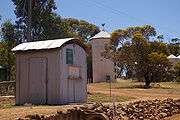
Dowerin, Western Australia
Dowerin is a town and shire located north-east of Perth in the central Wheatbelt region of Western Australia.-History:In 1906 the government extended the railway from Goomalling to the developing Dowerin Agricultural Area and decided to develop a townsite at the terminus...
farmer tried to lease Drumclyer after losing his property there from drought, but was unable to negotiate an acceptable rate. In December, the Hancock brothers had abandoned lots 1 & 2, Isbister had also abandoned Lot 13, although it is not known exactly when, leaving only the 780 acres (3.2 km²) of Lot 4 in private hands. With the outbreak of World War I
World War I
World War I , which was predominantly called the World War or the Great War from its occurrence until 1939, and the First World War or World War I thereafter, was a major war centred in Europe that began on 28 July 1914 and lasted until 11 November 1918...
the Agricultural College plans were abandoned as well.
Near the end of 1916, the Beverley community requested that Avondale be subdivided in to 20 lots for returning Soldiers. It was also suggested that Avondale be a nursery where soldiers are given small allotments and those that succeed are then given larger grants elsewhere in the state. In July 1918, it was decided that Avondale would have 6 lots made available for servicemen from the Beverley area and that 1740 acres (7 km²) which included the area around the homestead was to remain under control of the Lands Department.
Department of Agriculture
The original homestead block faced an uncertain future for many years, until it was given to the Department of Agriculture in 1924. Initially intended for the production of pure seed wheatWheat
Wheat is a cereal grain, originally from the Levant region of the Near East, but now cultivated worldwide. In 2007 world production of wheat was 607 million tons, making it the third most-produced cereal after maize and rice...
and oats
OATS
OATS - Open Source Assistive Technology Software - is a source code repository or "forge" for assistive technology software. It was launched in 2006 with the goal to provide a one-stop “shop” for end users, clinicians and open-source developers to promote and develop open source assistive...
, very little was produced for several years. Avondale was used as an assembly and holding ground for dairy
Dairy
A dairy is a business enterprise established for the harvesting of animal milk—mostly from cows or goats, but also from buffalo, sheep, horses or camels —for human consumption. A dairy is typically located on a dedicated dairy farm or section of a multi-purpose farm that is concerned...
cattle
Cattle
Cattle are the most common type of large domesticated ungulates. They are a prominent modern member of the subfamily Bovinae, are the most widespread species of the genus Bos, and are most commonly classified collectively as Bos primigenius...
, prior to them being sent to group settlers
Group Settlement Scheme
The Group Settlement Scheme was an assisted migration scheme which operated in Western Australia from the early 1920s. It was engineered by Premier James Mitchell and followed on from the Soldier Settlement Scheme immediately after World War I...
in the state's South West. During this period, the Silo was built with a capacity of 100 tonnes; the silo is now heritage listed.
The local farming community raised concerns about cattle being unsuitable for the area, while the concerns were not immediately addressed Avondale was turned towards seed production and research. The first research began in 1926; this was in the application of superphosphate its alternatives and the timing of application. Initial results were published in the Journal of Agriculture in 1927.
Research
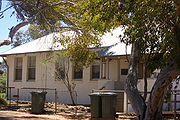
Braxy
Braxy is an inflammatory disease in the abomasal lining of sheep caused by the bacterium Clostridium septicum .Braxy is often brought on by a change from succulent food to dry food...
originated in the Beverley-York
York, Western Australia
York is the oldest inland town in Western Australia, situated 97 km east of Perth in the Avon Valley near Northam, and is the seat of the Shire of York...
region in 1915. Over the next 15 years it spread across most of the state's farming districts. Flock losses generally were around 5% though there were reported cases of 30% loss. In 1918 Professor Dakin of the University of Western Australia
University of Western Australia
The University of Western Australia was established by an Act of the Western Australian Parliament in February 1911, and began teaching students for the first time in 1913. It is the oldest university in the state of Western Australia and the only university in the state to be a member of the...
identified the disease as a toxaemia of bacteria
Bacteria
Bacteria are a large domain of prokaryotic microorganisms. Typically a few micrometres in length, bacteria have a wide range of shapes, ranging from spheres to rods and spirals...
l origin but was unable to establish the source.
Dr Harold Bennetts
Harold William Bennetts
Harold William Bennetts CBE was a Veterinary surgeon known for his ground-breaking research into diseases and pathogens of livestock, especially the toxic effects of some native Australian plants.Born in Carlton, Victoria...
was appointed the state's first veterinary pathologist in May 1925. Bennetts commenced an immediate investigation into the disease, using alleyways and open space around the department's city offices to house the sheep needed for the research. In 1930 a field laboratory was built at Avondale; a flock of 1000 sheep were purchased to enable feed experiments. In 1931 Bennetts had identified Bacillus ovitoxicus
Bacillus
Bacillus is a genus of Gram-positive, rod-shaped bacteria and a member of the division Firmicutes. Bacillus species can be obligate aerobes or facultative anaerobes, and test positive for the enzyme catalase. Ubiquitous in nature, Bacillus includes both free-living and pathogenic species...
as the cause of the disease. With this knowledge he was able to develop the infectious enterotoxaemia vaccine
Vaccine
A vaccine is a biological preparation that improves immunity to a particular disease. A vaccine typically contains an agent that resembles a disease-causing microorganism, and is often made from weakened or killed forms of the microbe or its toxins...
; for his efforts Bennetts received a CBE
Order of the British Empire
The Most Excellent Order of the British Empire is an order of chivalry established on 4 June 1917 by George V of the United Kingdom. The Order comprises five classes in civil and military divisions...
.
The sheep populations that were required by Bennetts at Avondale also afforded additional research opportunities. From 1931 for several years experiments were conducted with the object of determining how to best produce prime export lambs. This investigated various breeds and cross breeds determining that cross-bred ewes where significantly more productive than pure-bred Merino
Merino
The Merino is an economically influential breed of sheep prized for its wool. Merinos are regarded as having some of the finest and softest wool of any sheep...
s.
In 1934, Bennetts teamed with state botanist Charles Gardner
Charles Gardner
Charles Austin Gardner was a Western Australian botanist.Born in Lancaster, England on 6 January 1896, he emigrated to Western Australia with his family in 1909....
to study the toxic effect of native plants species on sheep. Gardner would collect the plants and supply them fresh to Bennetts who would then feed them to the sheep. They confirmed 24 species of plants as being poisonous, most which were from the native pea genera Gastrolobium
Gastrolobium
Gastrolobium is a genus of flowering plants in the family Fabaceae. There are over 100 species in this genus, and all but two are native to the south west region of Western Australia....
and Oxylobium
Oxylobium
Oxylobium , also known as Shaggy Pea, is a genus of flowering plants in the family Fabaceae . The genus is native to Australia.Species include:*Oxylobium aciculiferum Benth....
. Based on this and later research, Gardner and Bennetts published The Toxic Plants of Western Australia in 1956. During 1935, investigations into the effects of castrating
Castration
Castration is any action, surgical, chemical, or otherwise, by which a male loses the functions of the testicles or a female loses the functions of the ovaries.-Humans:...
male lambs with either mechanical pincers compared to using a knife, both of these methods have since been replaced with rubber elastrator rings. The experiment on 499 sheep concluded that no significant differences were observable in respect of mortality, maturity rates and meat quality.
Dr Eric Underwood began his research at Avondale in the mid 1930s also utilising the sheep flocks. Underwood's initial research was into the effects of sulfur
Sulfur
Sulfur or sulphur is the chemical element with atomic number 16. In the periodic table it is represented by the symbol S. It is an abundant, multivalent non-metal. Under normal conditions, sulfur atoms form cyclic octatomic molecules with chemical formula S8. Elemental sulfur is a bright yellow...
on wool growth, he followed that research with investigations into botulism
Botulism
Botulism also known as botulinus intoxication is a rare but serious paralytic illness caused by botulinum toxin which is metabolic waste produced under anaerobic conditions by the bacterium Clostridium botulinum, and affecting a wide range of mammals, birds and fish...
in sheep during 1935. These experiments were the first of many by Underwood over the next 30 years. During the 1940s he studied the nutritional value
Nutrition
Nutrition is the provision, to cells and organisms, of the materials necessary to support life. Many common health problems can be prevented or alleviated with a healthy diet....
of hay and pasture for sheep, the ongoing results from these Studies in Cereal Hay production in Western Australia were published in the Journal of Agriculture.

World War II
World War II, or the Second World War , was a global conflict lasting from 1939 to 1945, involving most of the world's nations—including all of the great powers—eventually forming two opposing military alliances: the Allies and the Axis...
, Avondale farm provided research into farming of linseed and flax
Flax
Flax is a member of the genus Linum in the family Linaceae. It is native to the region extending from the eastern Mediterranean to India and was probably first domesticated in the Fertile Crescent...
in Western Australia, although it was not the most suitable location for growing either. Three varieties of Linseed were trialled: Riga Crown, an early maturing variety, Italian also early maturing and Walsh, a mid-season maturing variety. It was discovered that all were susceptible to cutworm
Cutworm
Cutworms are not worms, biologically speaking, but caterpillars; they are moth larvae that hide under litter or soil during the day, coming out in the dark to feed on plants...
with greater damage occurring later in the season; early trails of the insecticide
Insecticide
An insecticide is a pesticide used against insects. They include ovicides and larvicides used against the eggs and larvae of insects respectively. Insecticides are used in agriculture, medicine, industry and the household. The use of insecticides is believed to be one of the major factors behind...
DDT
DDT
DDT is one of the most well-known synthetic insecticides. It is a chemical with a long, unique, and controversial history....
was said to show promising results in combating this.
Other efforts
In 1942 there was some pioneering in the development and use of contour banks, the equipment required a team 4 horses or two Clydesdales, a teamsterTeamster
A teamster, in modern American English, is a truck driver. The trade union named after them is the International Brotherhood of Teamsters , one of the largest unions in the United States....
and two labourers. Through the 1950s Avondale had monitored its sheep flocks as part of the research into Dwalganup strain of clover
Clover
Clover , or trefoil, is a genus of about 300 species of plants in the leguminous pea family Fabaceae. The genus has a cosmopolitan distribution; the highest diversity is found in the temperate Northern Hemisphere, but many species also occur in South America and Africa, including at high altitudes...
as a livestock feed and its effect on ewe fertility. On into the 1960s and 1970s Avondale was involved with the breeding and trial of various cereal crops for use within Western Australia. Since the early 1980s Avondale has focused on environmental and sustainable farming along with farm income supplemental alternatives like marron
Marron
Marron is a name given to two closely related species of crayfish in Western Australia. Formerly considered a single species, it is now thought to comprise two species, the critically endangered Cherax tenuimanus, and the species which is outcompeting it, Cherax cainii.Marron make excellent eating,...
farming.
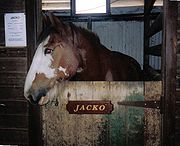
Clydesdale
Clydesdale was formerly one of nineteen local government districts in the Strathclyde region of Scotland.The district was formed by the Local Government Act 1973 from part of the former county of Lanarkshire: namely the burghs of Biggar and Lanark and the First, Second and Third Districts...
s in particular for pulling farming equipment. Farm economics of the 1930s meant that the Clydesdales weren't retired to enjoy the governments grassy paddocks. In 1937 a letter to the Agricultural minister details the disposal of horses that were no longer useful;
The letter details how the Perth Zoo
Perth Zoo
The Perth Zoo is a zoo that opened in 1898 in South Perth, Western Australia. As of January 2011, it is home to 1258 animals of 164 species and includes an extensive botanical collection....
is responsible for the freight and that the Minister had approved the transaction. Many Clydesdales were to follow the first two bay mares with the consignment note description for lions food, freight payable by consignee. This practice continued until well into 1950s until tractors replaced the use of horses in farming. Since the opening of the museum in 1978 Avondale again utilised Clydesdales for demonstrations of the old equipment these horse are sold as pets once they are incapable of working.
1976 to present
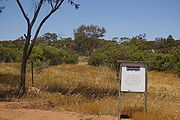
WAY 1979
WAY '79, also referred to as WAY 79 and WAY 1979, was the official 1979 sesquicentennial celebration of the colonisation of Western Australia by Europeans.-Planning:...
, the Department of Agriculture decided to restore the historic Avondale farm to its original state to display the achievements of Western Australian farmers. In response to the announcement, farmers from around the state responded generously with donations of old machinery and equipment. Most of this machinery was restored by Department of Agriculture mechanics. In 1978 an invitation to visit and open Avondale's agricultural displays was sent to Prince Charles
Charles, Prince of Wales
Prince Charles, Prince of Wales is the heir apparent and eldest son of Queen Elizabeth II and Prince Philip, Duke of Edinburgh. Since 1958 his major title has been His Royal Highness The Prince of Wales. In Scotland he is additionally known as The Duke of Rothesay...
, this was accepted and on 16 March 1979 Avondale was officially opened with commemorative tree planting near the entrance to the farm.
The farm continues its research into improving farming and farm practices under Western Australian conditions. Avondale's displays are open to the public with picnic facilities available, included in the displays are the original homestead, the stables complete with Clydesdale
Clydesdale
Clydesdale was formerly one of nineteen local government districts in the Strathclyde region of Scotland.The district was formed by the Local Government Act 1973 from part of the former county of Lanarkshire: namely the burghs of Biggar and Lanark and the First, Second and Third Districts...
s and a machinery shed. There is also road maintained around the farm with information boards on each paddock explaining its current usage.

